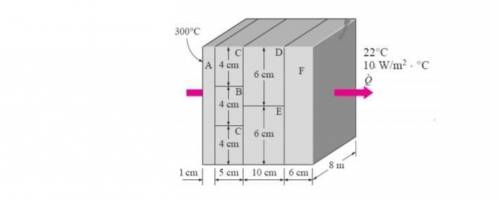
Engineering, 22.06.2020 20:57 KaseyT
Consider high, long, and thick wall whose cross section is given in
figure. Thermal conductivities of various materials used, in , are
, , , , and . The left surface of wall is maintained at
and right surface of wall is subjected to convection with outdoor temperature
and . Assuming heat transfer through wall is one-
dimensional, determine (a) heat transfer rate through wall; (b) temperature at point
where sections , , and meet; and (c) temperature drop across section ; d) right
wall surface temperature. Disregard any contact resistances at interfaces.


Answers: 3
Another question on Engineering

Engineering, 04.07.2019 18:10
The higher the astm grain-size number, the coarser the grain is. a)-true b)-false
Answers: 3

Engineering, 04.07.2019 18:10
Apipe with an outside diameter of 15 cm is exposed to an ambient air and surrounding temperature of -20°c. the pipe has an outer surface temperature of 65°c and an emissivity of 0.85. if the rate of heat loss from the pipe surface is 0.95 kw per meter of length, the external convective heat transfer coefficient (h) is: (a) 12.5 w/m"k (b) 18.6 w/mk (c) 23.7 w/mk (d) 27.9 w/mk (e) 33.5 w/mk
Answers: 1

Engineering, 04.07.2019 18:10
Shafts are machine elements that are used to a) carry axial loads b) direct shear loads c) transmit power d) rotate at constant speed e) none of the above circular and square shafts subjected to the same torque under the same circum behave a) the same way b) almost the same way
Answers: 2

Engineering, 04.07.2019 18:10
Draw the engineering stress-strain curve for (a) bcc; (b) fcc metals and mark important points.
Answers: 1
You know the right answer?
Consider high, long, and thick wall whose cross section is given in
figure. Thermal conductivities...
Questions

Mathematics, 30.07.2019 16:10













Physics, 30.07.2019 16:10

Biology, 30.07.2019 16:10


Mathematics, 30.07.2019 16:10





